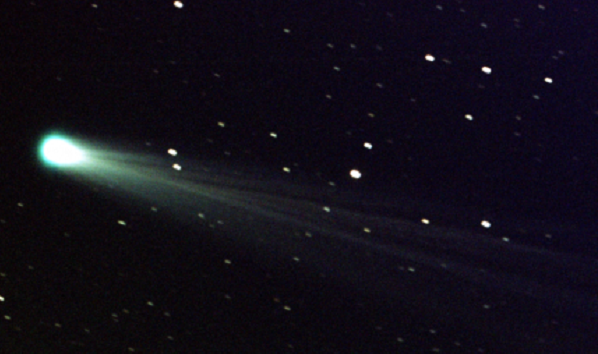Comet ISON Carries Piece of Primordial Solar System. Will the Sun Destroy it on Thanksgiving?

A NASA image of Comet ISON taken on Nov. 19th with a telescope near Marshall Space Flight Center
Science fans will get our own special entertainment on Thanksgiving this year. In addition to the usual football and college basketball games, the afternoon will offer a comet slinging around the sun. Scientists are giving it between 30 and 40 percent odds of surviving. Comet ISON has been traveling toward us for more than a million years. It once lived peacefully in a very distant orbit far past all the planets, but then another star swung by close enough to perturb its orbit, sending ISON careening toward the sun.
On Thanksgiving, it will pass within a million miles of the sun – a tiny fraction of the Earth’s comfortable distance of 93 million miles. The comet may break up or it may survive and produce a beautiful show in the early mornings and evenings of early December.
At a NASA press conference convened on Wednesday, scientists said they were happy either way because for the last few months they’ve been studying the comet intensely with the Hubble Space Telescope and a handful of other orbiting and ground-based instruments. They’ve studied it with spacecraft that are orbiting Mars and Mercury. They’ve imaged it in visible light, UV and infrared.
Why get so excited about a comet? For one thing, comets represent frozen samples of the material from which the solar system formed, explained Carey Lisse, a comet expert from the Johns Hopkins Applied Physics Laboratory. Our current picture holds that the solar system coalesced from gas and dust that clumped together into comets, some of those clumping together to form planets. Other comets stayed to themselves, finding their own orbits around the sun, in regions known as the Kuiper Belt and the more distant Oort cloud.
Lisse describes comets as dirty snowballs – very loosely packed collections of dust and ice. Earlier comet observations have revealed organic molecules such as hydrocarbons and even amino acids – a building block of living organisms.
The Oort cloud extends to about half way between the sun and the next nearest star, said astrophysicist Karl Battams of the Naval Research Laboratory. ISON, he said, is the first comet scientists have observed that both came from the distant Oort Cloud and will graze the sun. “We have no past experience to predict what’s going to happen,” he said. “But whether it survives the journey or fades away, we’ll learn a great deal.”
If it survives, our one chance to see it will be in early to mid-December, toward the West after Sunset and the East before sunrise. The scientists said ISON is not tracing out an elliptical orbit. The path traces out a hyperbola – something like a U-shape. It comes in from one direction, and leaves another, never to return.
WHYY is your source for fact-based, in-depth journalism and information. As a nonprofit organization, we rely on financial support from readers like you. Please give today.

